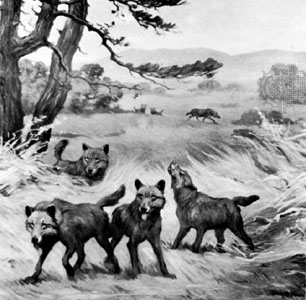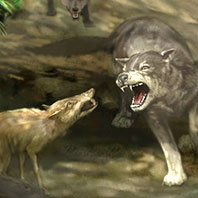
October 11, 2010

Dire wolf from Rancho La Brea, Calif.; detail of a mural by Charles R. Knight, 1922.

The Bullyland replica of the Dire Wolf (Canis dirus).
This weekend, due to a variety of reasons, I find myself in southern California. I have made a side trek to the La Brea tar pits. Do you all recall MonsterQuest’s “Mutant Canines” episode?
Up in Maine, many people watched that program, as the story line involved local people and Pine State encounters. Maine remains the most wooded state in the United States, a little known fact to most of America’s residents. Indeed, 95% of the state’s surface is covered in trees and only a million people live in a state that is the size of all of the rest of New England. But enough about how wonderful my home state is for leftover megafauna, like moose, wolves, and cougars.
I did have some morning-after reactions to MonsterQuest’s 2007 broadcast, which I want to revisit, after viewing the tar pits.
A few people watching seem to think, due to editing, that I said the Maine canid creatures could be Pleistocene or Ice Age survivors, specifically the dire wolves (Canis dirus). Needless to say, I never said that I thought the “Maine Mutant” was a dire wolf. Any narrator notions that the nostrils even looked like a wolf, let alone a dire wolf, were off-base. That animal on the ground in Turner was a dead dog, which due to initial decomposition, showed more teeth that usual because the lips do pull back on dead carcasses.

The Carnivores of Rancho La Brea.
From left to right. The dire wolf (Canis dirus), the sabre-toothed cat (Smilodon fatalis), the short-faced bear (Arctodus simus), the cheetah-like cat (Miracinonyx sp.), and the American lion (Panthera leo atrox). Modified from Turner, A., and Anton, M., The Big Cats and Their Fossil Relatives. Columbia University Press: New York, 1997.
In any comprehensive media interview about reports of canid cryptids (Skunka Warak’in to Waheela), which are researched for decades, obviously, I would discuss all the theories and candidates being thrown out there. That is why there would be a mention of dire wolves. But that does not mean that I seriously would consider it an option for the reports in, say, Maine. Interviews are edited and conversations are shortened for television.
Regarding the dead animal found in Turner, for melodramatic effect, its identity was teased for some time on the MonsterQuest program. But everyone knew it was a dog as soon as that show began pre-production, as well as shooting in Maine.
I found it curious that despite the fact that two labs had already given us a DNA “dog” verdict with fresh tissue samples in 2006, here we find that MonsterQuest did another DNA round of testing with old, dried tissue, at a NYU lab in 2007. I take it this was done to create documentary tension, and so they could film the process and the lab scientist’s “new” final results. It makes for good television, I suppose.
Overall, though, I thought the “Mutant Canines” program was sort of one of those middle of the road episodes for the MonsterQuest series. It really is too bad they weren’t able to do an “update,” as often appeared on the old “In Search of…” series. In such a bulletin, MonsterQuest could have told about the discovery, 121 years later, of the Shunka Warak’in taxidermy mount recently. But then, here in 2010, we are still waiting for DNA results on that one, aren’t we?
Also, perhaps with more time, they could have included details of the compelling story of the sightings of the Waheela, which definitely overlap with the rest of the material in the program.
The Waheela is a ghostly, snow-white wolf-like cryptid reported by Inuits, Indians, and EuroAmerican trappers from Alaska and Canada, especially in the Nahanni Valley in the Northwest Territories. Zoologist Ivan Sanderson, who collected stories from his friends, thought that the Waheela might represent a relict population of Amphicyonids, prehistoric bear-dogs, or even the dire wolves.

Dire wolf. NOVA image.
Explorer Frank Graves described the Waheela as 3.5 feet high at the shoulders with a wide head and short legs, covered in a shaggy white coat. He saw it in the mid-1960s in the Nahanni Valley. Another Sanderson friend, photojournalist Tex Zeigler reportedly saw a Waheela on the tundra of Alaska. These northern reports also match the tales of the Amarok, a giant wolf from Inuktitut mythology.
When I was working with Sanderson, I shared with him the similar stories I gathered from the Indiana University archives. One specifically was of three trappers in northern Michigan who encountered a phantom-like giant white wolf that mirrored the Waheela sightings.
As to the program’s statements about whether the Shunka-Warak’in travels in packs, no one knows. The one sighting that is well-documented is from the 1880s, and that could have been one individual animal. Wolves, well-known pack animals, are seen individually too.
The oft-repeated statement that “it is known” that dire wolves traveled in packs is pure speculation. The number one animal found in the La Brea tar pits was the dire wolf (3,600 individuals), and that is often used as some kind of verification that the dire wolves were pack animals, especially if aligned with modern timber wolf behavior.
But do you know what the number two most frequent animal found in the tar pits is? It is the saber-tooth cat, Smilodon. Does that mean that saber-tooths traveled in packs? No, of course, not. All it means is that dire wolves and saber-tooths, in large numbers, were attracted to feed on the other animals stuck in the tar pits and then became trapped themselves.
At the tar pits, a dire wolf and saber-tooth cat fight over the same morsel.
Megafauna mysteries come in many packages.
About Loren Coleman
Loren Coleman is one of the world’s leading cryptozoologists, some say “the” leading living cryptozoologist. Certainly, he is acknowledged as the current living American researcher and writer who has most popularized cryptozoology in the late 20th and early 21st centuries.
Starting his fieldwork and investigations in 1960, after traveling and trekking extensively in pursuit of cryptozoological mysteries, Coleman began writing to share his experiences in 1969. An honorary member of Ivan T. Sanderson’s Society for the Investigation of the Unexplained in the 1970s, Coleman has been bestowed with similar honorary memberships of the North Idaho College Cryptozoology Club in 1983, and in subsequent years, that of the British Columbia Scientific Cryptozoology Club, CryptoSafari International, and other international organizations. He was also a Life Member and Benefactor of the International Society of Cryptozoology (now-defunct).
Loren Coleman’s daily blog, as a member of the Cryptomundo Team, served as an ongoing avenue of communication for the ever-growing body of cryptozoo news from 2005 through 2013. He returned as an infrequent contributor beginning Halloween week of 2015.
Coleman is the founder in 2003, and current director of the International Cryptozoology Museum in Portland, Maine.
Filed under Breaking News, Cryptid Canids, Cryptomundo Exclusive, Cryptotourism, CryptoZoo News, Cryptozoologists, Cryptozoology, Evidence, Eyewitness Accounts, Folklore, Forensic Science, Fossil Finds, Media Appearances, Men in Cryptozoology, MonsterQuest, Museums, Mystery Cats, Television